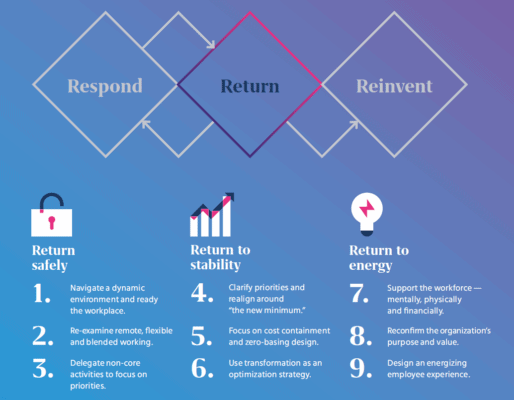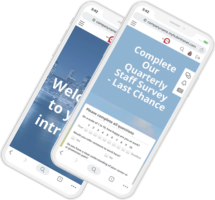Around the world, employees are tentatively returning to workplaces.
But not wholesale.
And not like before.
So what does new normal working look like? The experience of New Zealand – where MyHub was born – offers some unique insights. Our island nation remains cautiously optimistic in our fight against Covid-19. There have been no cases of community transmission since April 2020, following a severe 7-week lockdown. Since then, New Zealand has mostly eradicated the virus, bar a handful of cases contained at the border.
We are acutely aware that a resurgence remains a real threat, but also recognize we must get on with the job of protecting and growing the economy.
Since the easing of lockdown restrictions in April, the country has steadily reopened for business. In many ways, life has returned to normal. Shopping malls are busy. Traffic is back. And friends and families have reunited.
But how we work has fundamentally changed. So, what can other countries learn from the Kiwi experience? And what should businesses do to prepare for the new normal working, where the emphasis is on digital working?
New Normal Working: New Zealand-style
The lockdown experience has demonstrated just how adaptable organizations and people are. The overnight shift to remote working has shown not everyone needs to be in the office all the time.
It may be early days, but already there’s a noticeable move to a more blended work culture in New Zealand. Many businesses have staggered the return to work as being more manageable and safer. A high number of employees have continued home-working at least some of the time. A hybrid model has emerged.
The new requirements around social distancing and hygiene have also led to changes in the physical workplace. The once on-trend model of open-plan offices, hot-desking and co-working spaces has not survived the virus. Ramped up cleaning protocols and a ready supply of sanitizers and disinfectant wipes are now in order. Similarly, organizations have limited the use of meeting rooms and shared kitchens. And they have reduced foot traffic flows in workplaces.
Caption: Auckland, New Zealand
The new normal that has emerged in New Zealand is a hybrid model, which supports on-site working alongside telecommuting.
And workers prefer it that way.
A University of Otago study of more than 2,500 Kiwis discovered that 89 percent wanted to continue working remotely after the end of lockdown. The study found that participants welcomed the increased flexibility working from home offered. Not having to face a daily commute or traffic jams were the top advantages identified by participants. Also mentioned were the positive environmental impact with reduced emissions and fewer costs from not having to go work. And when it comes to productivity while working remotely, study participants were very positive.
Most people (73 percent) felt that they were equally or more productive working remotely. And 66 percent found it easy or somewhat easy to work remotely.
However, the study also identified several downsides to home working. Participants felt that communication and collaboration with their colleagues were harder. And for parents or caregivers, balancing work and family was challenging. The rush to home working meant that not all employees could enjoy a dedicated home workspace. Many were sharing the dining table with co-working partners and home-schooled children.
Further issues identified by participants include mental health wellbeing, an inability to switch off from work, and sustaining motivation.
In New Zealand, it seems clear already that the new normal will be very different. Companies are now grappling with addressing the challenges of remote working while also embracing it as the future.
Undoubtedly, working from home is here to stay. The pandemic has simply accelerated an existing trend. After all, remote working offers employees greater flexibility and a better work-life balance. And it also has benefits for companies, including reduced office expenses and central overheads.
So, what can companies do to prepare workers for the new normal beyond Covid-19? Here are four initiatives to consider, based on the Kiwi experience.
1. Sustaining The Motivation Of Remote Workers
How to stay motivated is a perennial problem for remote workers. Without co-workers to enthuse and energize you, is it possible to maintain productivity and sustain motivation?
Well, the experience of lockdowns worldwide suggests that home workers’ productivity isn’t an issue as previously thought it was. Alongside the Otago University study, there are other reports that confirm remote workers are productive.
The Owl Labs 2019 State of Remote Work report discovered those who work from home are happier. And they are also 13 percent more likely to stay at their current job for the next five years than their workplace-based counterparts.
A ground-breaking two-year longitudinal study from Stanford University found out that productivity increases among the telecommuting workforce. According to the researchers, fewer distractions and more focus when working led to massive increases in telecommuters’ productivity.
However, while productivity remains high for the majority, motivation can be a problem, especially among isolated home workers. Managers should be tuned into the needs of their staff. And co-workers should be vigilant in looking out for any early warning signs in their colleagues.
Possible indicators of a motivational problem, or worse still, a mental health issue include the following:
- failure to meet deadlines
- new performance issues
- lateness or poor engagement in meetings
- slow and/or poor response to messages
Furthermore, even though lockdown restrictions are being eased in most countries, the threat of a second wave remains significant. Many staff will be feeling anxious about the future. They may have lost loved ones or colleagues to coronavirus. Or perhaps they have health conditions or caring responsibilities which make them vulnerable. In the face of more fundamental concerns, maintaining your motivation at work can take second place.
According to Mercer’s report Return to a New Normal, one in three employees experience mental health issues because of social isolation and economic anxiety. Its report highlighted nine essentials for returning to a new normal, defined under three categories: respond, return, and reinvent, and emphasized the importance of supporting the workforce – mentally, physically and financially.

2020 Mercer Report – Return To A New Normal
It’s vital that companies show a duty of care and kindness. New Zealand’s Prime Minister Jacinda Ardern repeatedly says we must all ‘be kind’ to our fellow kiwis. This mantra has been adopted by businesses, and internal campaigns launched that celebrate and promote employee acts of kindness. Many companies have produced wellness resources for their employees. Whether it’s online resources, self-help checklists, or helplines, make sure employees know where to access professional help.
Sustain motivation by carrying on with any workplace traditions. Celebrate birthdays, good news, or achievements outside work. Keep up the lockdown tradition of bake-offs or quizzes to connect remote workers and office staff.
All of these office traditions will help sustain motivation. In addition, keep corporate communications as upbeat as possible and celebrate every achievement.
Managers are central to maintaining motivation. Ensure they have the skills to recognize staff that are lacking motivation and may be at risk of becoming disengaged. One study discussed in the Harvard Business Review suggests that the best managers regularly check in with remote workers. In the new normal, managers have to be equipped to know what support or guidance staff need.
2. Helping Remote Workers Switch Off From Work
When the boundaries between work and home are blurred, mentally switching off can be a problem. Indeed, that’s the view of participants in the University of Otago study. Exhaustion was a major gripe from many of the study’s participants.
Encourage your workers to develop a set routine and stick with it. The working day still needs a start and end time, especially when your desk is just a few feet from the bed.
Some workers kick-start their home working day with a workout or a brisk walk. It’s great for getting you energized and ready to focus on the job. Likewise, proper nutrition is important. It’s hard to stay on task if your stomach is rumbling because you skipped breakfast.
Get workers to schedule regular breaks throughout the day. Why not set up a #timeout channel on the team chat. Workers can get together over a virtual coffee for casual conversation just as they would in the physical workplace.
At the close of the working day, employees need to shut down their laptops and turn off notifications. That mindset of finishing work for the day is even more important for home workers. And managers have an essential role to play in modeling the right behavior themselves. Late-night emails and phone calls should be avoided unless it’s an emergency.
3. Facilitating Collaboration, Communication and Innovation Remotely
Opportunities to collaborate and communicate with colleagues was the second biggest challenge for participants in the Otago University study. ‘Zoom fatigue’ was a common complaint. Many of the study’s participants claimed that they were attending more virtual meetings than ever!
Certainly, there are plenty of communication tools out there. Possibilities include intranet software, video and audio conferencing apps, social media, cloud-office platforms, and instant messaging.
But clearly, they need to be fit for purpose. And right for your culture.

Involve staff in selecting the right suite of collaboration tools for your business. Find out what worked well for them over lockdown and what needs to improve. A snap poll, staff survey or employee pulse check could provide some surprising insights. The ‘Zoom fatigue’ factor is unlikely to be unique to New Zealand. Also, use this unprecedented experience to think outside the square. Necessity is the mother of all invention and ingenuity should be encouraged. Ironically, the pandemic has provided an opportunity for businesses to find new ways to bounce back.
Furthermore, make sure staff know what tools to use and when. Staff will need guidance as they transition into a digital working style. For example, team chat is a quicker and more effective platform for resolving simple queries than email. Forums and surveys are helpful modules to capture staff ideas. And newsletters are a great way to broadcast important information to a wider group.
And while you are reviewing communication and collaboration tools, don’t under-estimate the problem of isolation. When telecommuters complain about communication and collaboration, it’s often out of a sense of disconnection from the team. The real issue is the worker’s feeling of isolation.
Use technology to help your workers to maintain a sense of connection and company culture. Motivational video messages from senior leaders, CEO blogs, staff Q&A sessions are valuable communication tools.
And it will also help you deal with the problem of misinformation, rumor, and fake news that many companies experienced during the lockdown.
In fact, the 2020 Edelman Trust Barometer discovered that employer communications were the most credible source of information during the pandemic. Participants in the survey believed that ‘my employer’ was the most trusted institution ahead of the government and news outlets. This trust in employer communications is likely to continue as we enter the new normal.
4. Ensuring Staff Have Suitable Workspaces
Having the right home office set up is critical to the long-term success of remote working. The speed with which the pandemic took hold worldwide was unprecedented. There was little time to prepare, which meant many businesses became remote working almost overnight.

If workers are to continue with even part-time telecommuting, employers need to address this problem urgently.
Issue clear guidance around home office setups. From adequate ventilation and lighting to ergonomics, staff need sound advice. They also need to be aware of cybersecurity and their obligations to safeguard confidential personal or company information.
Plan And Prepare For The New Normal
You may not yet have a full picture of what the new normal means for your business. However, one thing is already clear. CNBC predicts that as a result of the pandemic forcing millions to work remotely, the US economy has reached a ‘tipping point’ in favor of home working.
It’s what we’re seeing here in New Zealand. And the unfolding of new normal working that is perhaps more empathetic, more innovative, and kinder than before.








